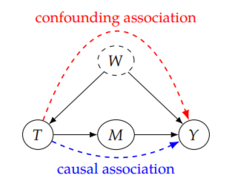“前门调整”的版本间的差异
跳到导航
跳到搜索
| 第2行: | 第2行: | ||
==调整目的: 因果效应估计== | ==调整目的: 因果效应估计== | ||
| − | 我们期望在给定如下因果图的情况下,判断治疗变量 T 对结果变量 Y 的因果效应 <math> P(y|do(t) | + | 我们期望在给定如下因果图的情况下,判断治疗变量 T 对结果变量 Y 的因果效应 <math> P(y|do(t))</math>,其中 W 是一个未观测的混淆变量,M 是中介变量。(注意:我们现在观测不到W,无法进行后门调整) |
[[文件:Front door.png|缩略图|229x229像素|前门调整]] | [[文件:Front door.png|缩略图|229x229像素|前门调整]] | ||
| 第9行: | 第9行: | ||
主要步骤如下<ref>https://www.bradyneal.com/Introduction_to_Causal_Inference-Dec17_2020-Neal.pdf</ref>: | 主要步骤如下<ref>https://www.bradyneal.com/Introduction_to_Causal_Inference-Dec17_2020-Neal.pdf</ref>: | ||
| − | #'''估计T对M的因果效应'''<math> P(m|do(t) | + | #'''估计T对M的因果效应'''<math> P(m|do(t))</math> ,由于T-W-Y-M 这条路径被 [[阻断]] (见 [[D-分离]]) <math> P(m|do(t))=P(m|t)</math> |
| − | #'''估计M对Y的因果效应'''<math> P(y|do(m) | + | #'''估计M对Y的因果效应'''<math> P(y|do(m))</math>, 由于 T 阻断了[[后门路径]] M<-T<-W ->Y, 根据[[后门调整]] 我们可以轻松得到<math> P(y|do(m))= \sum_t P(y|m,t) P(t)</math> |
| − | #结合以上两种因果效应 | + | #结合以上两种因果效应<math> P(y|do(t))= \sum_m P(y|do(m)) P(m| do(t))</math> |
==前门准则== | ==前门准则== | ||
2021年7月22日 (四) 16:44的版本
调整目的: 因果效应估计
我们期望在给定如下因果图的情况下,判断治疗变量 T 对结果变量 Y 的因果效应 [math]\displaystyle{ P(y|do(t)) }[/math],其中 W 是一个未观测的混淆变量,M 是中介变量。(注意:我们现在观测不到W,无法进行后门调整)
主要步骤如下[1]:
- 估计T对M的因果效应[math]\displaystyle{ P(m|do(t)) }[/math] ,由于T-W-Y-M 这条路径被 阻断 (见 D-分离) [math]\displaystyle{ P(m|do(t))=P(m|t) }[/math]
- 估计M对Y的因果效应[math]\displaystyle{ P(y|do(m)) }[/math], 由于 T 阻断了后门路径 M<-T<-W ->Y, 根据后门调整 我们可以轻松得到[math]\displaystyle{ P(y|do(m))= \sum_t P(y|m,t) P(t) }[/math]
- 结合以上两种因果效应[math]\displaystyle{ P(y|do(t))= \sum_m P(y|do(m)) P(m| do(t)) }[/math]
前门准则
有后门路径的定义,链接到后门调整
https://cse.sc.edu/~javidian/Notes_Presentations/BackFrontDoor.pdf
